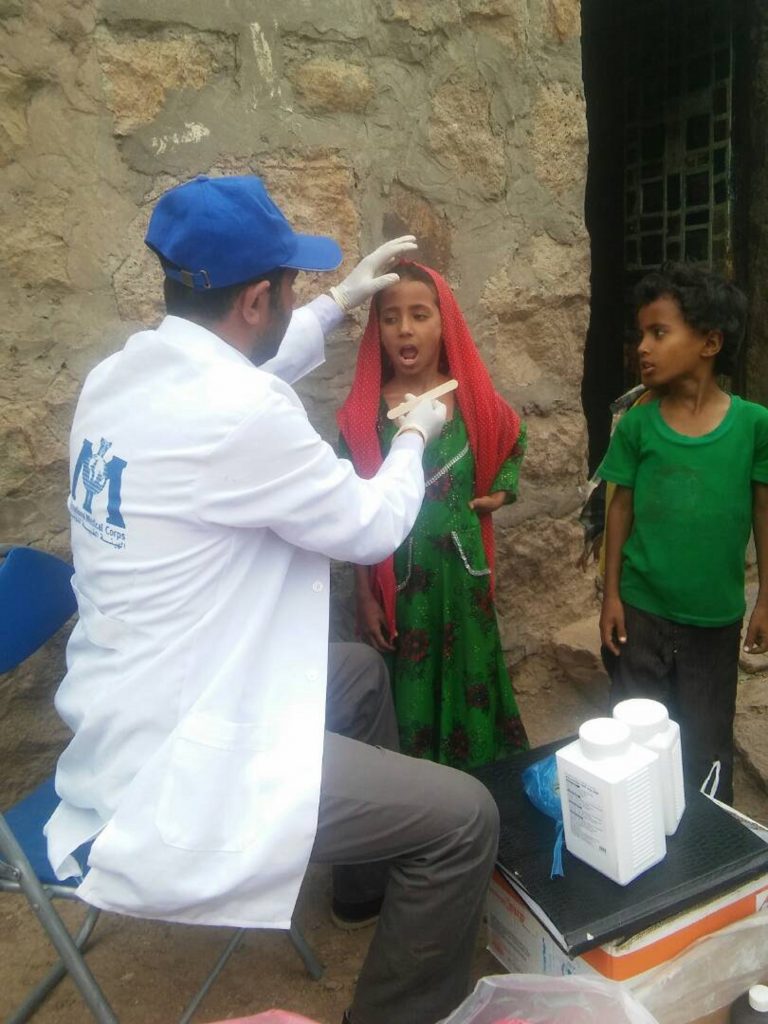The fate of young children in war-torn Yemen is captured in one heart-wrenching United Nations statistic: Every ten minutes, a child under five dies of causes that are easily preventable.
A civil war now in its fourth year has destroyed much of the country’s infrastructure, crippled its economic and commercial life and left three quarters of its 28 million people dependent on humanitarian assistance. An estimated two million have been displaced. The conditions have turned childhood for far too many Yemen’s young into a perilous journey fraught with dangers that include hunger, malnutrition and disease as well as the violence, disruption and death that accompany war.
Knowing these dangers, International Medical Corps responded to the health care needs of a group of Yemen’s most vulnerable children—its orphans. With the support of the Rathmann Family Foundation, we have renovated one floor of a three-story building into a well-equipped clinic for the 900 residents of the Orphan Care House in the capital, Sana’a. The clinic is also open to an additional 400 orphanage graduates now studying at local universities but who are still connected to the orphanage.

Including orphanage staff and low and no income families living in the surrounding neighborhoods who will eventually be able to use the new facility for a nominal fee, the total number expected to benefit from the new facility exceeds 5,000. In a country where government-backed health care is dwindling under the pressures of war, the orphanage clinic is nothing short of a godsend.
Conditions for Sana’a’s orphan children—and residents of nearby areas—in many ways are a microcosm of what is happening in much of Yemen. Government-run health clinics, referral hospitals and other essential services in the area have gradually disappeared as authorities run out of funds needed to keep them open. Basic health care services had effectively stopped for children at Orphan Care House.
When the Ministry of Finance halted payments to the contractor responsible for nutrition at the orphanage, deliveries of subsidized food stopped, sharply reducing meal sizes and varieties—an especially worrisome development in Yemen, where child malnutrition is widespread. And when cooking gas disappeared from local markets, orphanage kitchen staff have resorted to burning broken doors and old benches to cook meals.

With the new International Medical Corps-supported facility now open, the children once again have easily accessible health care, including vaccinations dental care and other routine treatment and preventative care.
With additional funding, orphanage managers hope to make health care for children at Orphan Care House self-sustaining by charging modest fees for more specialized services they plan to add and open to residents of surrounding neighborhoods. These include antenatal care, an operating room for normal and caesarian childbirth, emergency care with X-ray equipment and special clinics for malnutrition and psychiatric care and even an ambulance for transporting acute cases to the nearest fully-equipped public hospital.
If the plan succeeds, it would increase the survival chances for the young residents of Orphan Care House in a country where the risks for children are extraordinarily high.
According to Unicef more than 5,000 children have been killed or wounded in the violence since the war broke out in March 2015. That’s an average of five each day since the conflict began.

Indirectly, the war has exacerbated other dangers for Yemen’s children—dangers such as disease and hunger that even in the best of times are never far away. Infectious disease—including cholera, diphtheria and measles—are endemic. Last year, the war complicated efforts to contain a major outbreak of cholera, with more than 1.1 million suspected cases reported. Nearly 3 in 10 of those cases involve children under the age of 5, making them the single most vulnerable age group.
Only half the country’s health facilities remain functional. More than half Yemen’s 28 million people lack clean water, sanitation and hygiene services. Only potable water and medical supplies trucked in by International Medical Corps keep open most of the health facilities we support.
It was the fight against malnutrition that first brought International Medical Corps to Yemen in 2012 and the civil war has dealt a major setback to those efforts. The UN estimates that today, about half of all Yemeni children under 5 years are stunted. Some 1.8 million children and over one million pregnant or nursing mothers are acutely malnourished. Of these, 400,000 suffer from Severe Acute Malnutrition.
